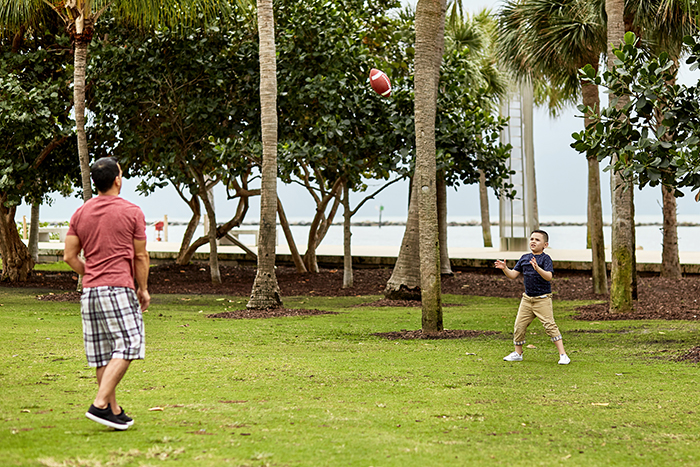A Healthy Family? It’s Just Outside the Front Door.

Parenting in the 21st century is an epic task.
Getting your kids active and engaged in real life interactions isn’t easy when you’re competing with digital devices. The habits that keep kids on the couch also contribute to rising childhood diabetes and obesity rates.
There is a simple way to change the family dynamic, however, and it’s as close as your front door.
“Don’t underestimate the value of an after-dinner family stroll around the neighborhood,” says Dr. E. Robert Schwartz, a family medicine specialist at the University of Miami Health System. “Walking is an easy way to reduce stress, add more activity to everyone’s day, and have conversations free from the distractions of chores, TV, and cell phones. It’s a chance to slow down the pace of life, even briefly. Everyone, kids included, needs that.”
If your neighborhood isn’t pedestrian-friendly, take advantage of Miami-Dade County’s extensive park system and beautiful beaches.
Families lucky enough to live close to school can skip the bus or carpool and walk instead. It takes a little longer, but parents save time by not having to hit the gym later. By walking to school or even to the bus stop, kids gain a deeper understanding of their surroundings. With your guidance, they learn which streets have more traffic and which ones are better for walking or riding bikes. By taking advantage of “teachable moments”, you discover new things together –from the names of flowers to the names of your neighbors.
Ready to lace up your sneakers?
While you’re out and about, don’t forget safety. “Young children cannot fully recognize and avoid dangerous traffic situations,” says Dr. Gillian Hotz, a neuropsychologist at the Health System’s KIDZ Neuroscience Center. To prevent childhood pedestrian injuries, the Center created WalkSafe, an injury prevention program. Dr. Hotz shares the Center’s tips for helping children become street smart:
- Children under age 10 should not walk by themselves. (Older children with developmental issues may also need a companion.) If you aren’t available, arrange to have an older, responsible sibling or adult walk with your child.
- When crossing the street or walking through a parking lot, hold your child’s hand.
- Late afternoon and early evening are especially dangerous for children because it’s harder for drivers and pedestrians to see. If your children are not in after-school programs, enforce strict rules about staying off the streets during these hours.
- Teach children to always cross at the crosswalk or street corner and to look left-right-left before crossing.
- Even if you get a white “walk” signal at a crosswalk, look before crossing. Distracted drivers may drive through crosswalks without stopping.
- Before crossing the street, make eye contact with the driver to make sure they see you.
- Model safe behavior. Never cross the street or walk through a parking lot or on a street while texting or staring at your cell phone.
- If there is no sidewalk, walk on the left side of the road, facing traffic. Stay as far off the road as possible.
- When walking at night, wear light-colored or reflective clothing and carry a flashlight.
Nancy Moreland is a contributing writer for UMiami Health News. She has written for several major health care systems and the Centers for Disease Control and Prevention. Her writing also appears in the Chicago Tribune.
Tags: childhood diabetes, childhood obesity, family exercise, family walk, Gillian Hotz, pedestrian safety, Sarah Messiah, screen time
